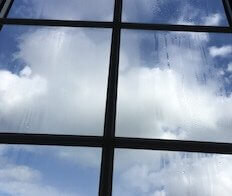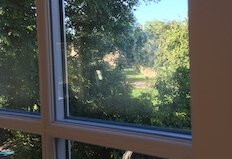Window Condensation
One of the most common questions that we get asked is “how do I stop condensation forming on my windows?”. And the most common answer is “well, it depends”! Read on to discover what type of condensation on windows that you have, and how to deal with it.
Why does Condensation Form on Windows?
- There are 3 different types of condensation on windows – all related to whereabouts on the glass that the water vapour is forming.
Condensation in-between two panes of glass
There is only one cause and one fix for this: the sealed unit is no longer sealed, and should be replaced. This not only means that your glass panes are no longer airtight but, as a result, the gas in-between the panes will have leaked out. Gases, such as argon or krypton, are often used to improve the performance of the window. If they are no longer contained, the window will be much less efficient.
Condensation on the outside of the window
Before you go ahead replacing glass, however, make sure that you check the pane of glass on the exterior of the building. If it turns out that the condensation is forming there, congratulations! You have a wonderful efficient window, most likely with an “energy pane”.
On an energy pane, there is a coating on the inner pane that reflects heat back into the room. After a cold night, you may find condensation in the middle of the outside of the window in the morning. This is because the outer glass pane is actually colder than the air outside.
As the temperature rises throughout the day, the mist will clear.Condensation on the inside of the window
Finally, the most common situation: condensation appearing on the inside of the glass. This is a little more complicated because, in some cases, going about fixing this problem the wrong way can make matters worse.
Yes, you could replace your windows with airtight, high performance units. But bear in mind that this may be simply treating a symptom, rather than the disease. The real issue is most likely the humidity of the room, rather than the performance of the window.
First, you should look to ventilating the room more effectively: damage caused by rot and damp conditions will be avoided by doing so. Ultimately, by replacing the window, without reducing the humidity, condensation will try to form somewhere. If not on a window, perhaps on a wall – which would do much more damage in the long run.
Enlightened Windows will always help you to find the best solution for your home. Feel free to contact us with any questions you may have.
How to Reduce a Room’s Humidity
The ideal humidity level is around 20-30%, with a 20 degrees air temperature. If in doubt, a temperature/humidity sensor can be bought for relatively little.
- The main all-encompassing solution is to increase your ventilation.
- Try to air the whole house for 5-10 mins a few times every day – not just the kitchen and bathrooms. Opening the windows of the kitchens and bathrooms only will simply move the air with highest humidity to a different room in the house, rather than outside.
- If you have trickle vents (also known as push vents), keep these open throughout the day. These provide background ventilation and, if the humidity is not too high to begin with, this may be the only fix you need.
- Remember to turn on extractor fans, or open windows/vents, when cooking or showering. And keep them open for 10-15 mins after you’ve finished.
Perhaps the last point there was an obvious one, but things like cooking, showering, drying clothes inside and simply the number of people and pets around the house will greatly alter the air temperature (and therefore humidity) inside. One single adult can quite easily be accounted for two litres of water vapour per day! Unquestionably, all these items contribute to condensation on windows.
Condensation has Suddenly Appeared
Due to an increase of humidity, windows can suddenly attract condensation, having never done so before. Normally, something will have changed in your home to make this happen, or it could just be the onset of winter.
- Common New Causes of Condensation:
- Time of Year: Autumn going into winter is the time of year where condensation is at its worst. Radiator being turned on: heating a building’s structure that wasn’t heated throughout summer creates moisture inside the house,
- Plants: yep, that trip to the garden centre may have more consequences than you thought! All living things,
plants included, naturally produce moisture. I’m not saying you should stop buying plants, but just note that putting them on a window may result in their water vapour cooling down against cold glass. - New Windows: high performance windows can improve insulation dramatically. Naturally, the difference in temperature between inside and outside is much more noticeable. In this case, condensation will be appearing on the outside. This is a good thing! It shows that your windows are doing their job.
- Recent Building Work: Building materials, like cement, plaster or paint, contain moisture, which does take time (even a whole year) to disappear completely.
Contact us!
For any questions about our products and services, or to get your quote,
please get in touch by phone, email, or using our in-browser contact form!
Leamington: 01926 935 607
London: 0203 633 0476
E-mail : sales@enlightenedwindows.co.uk
Contact Form: Contact Us









